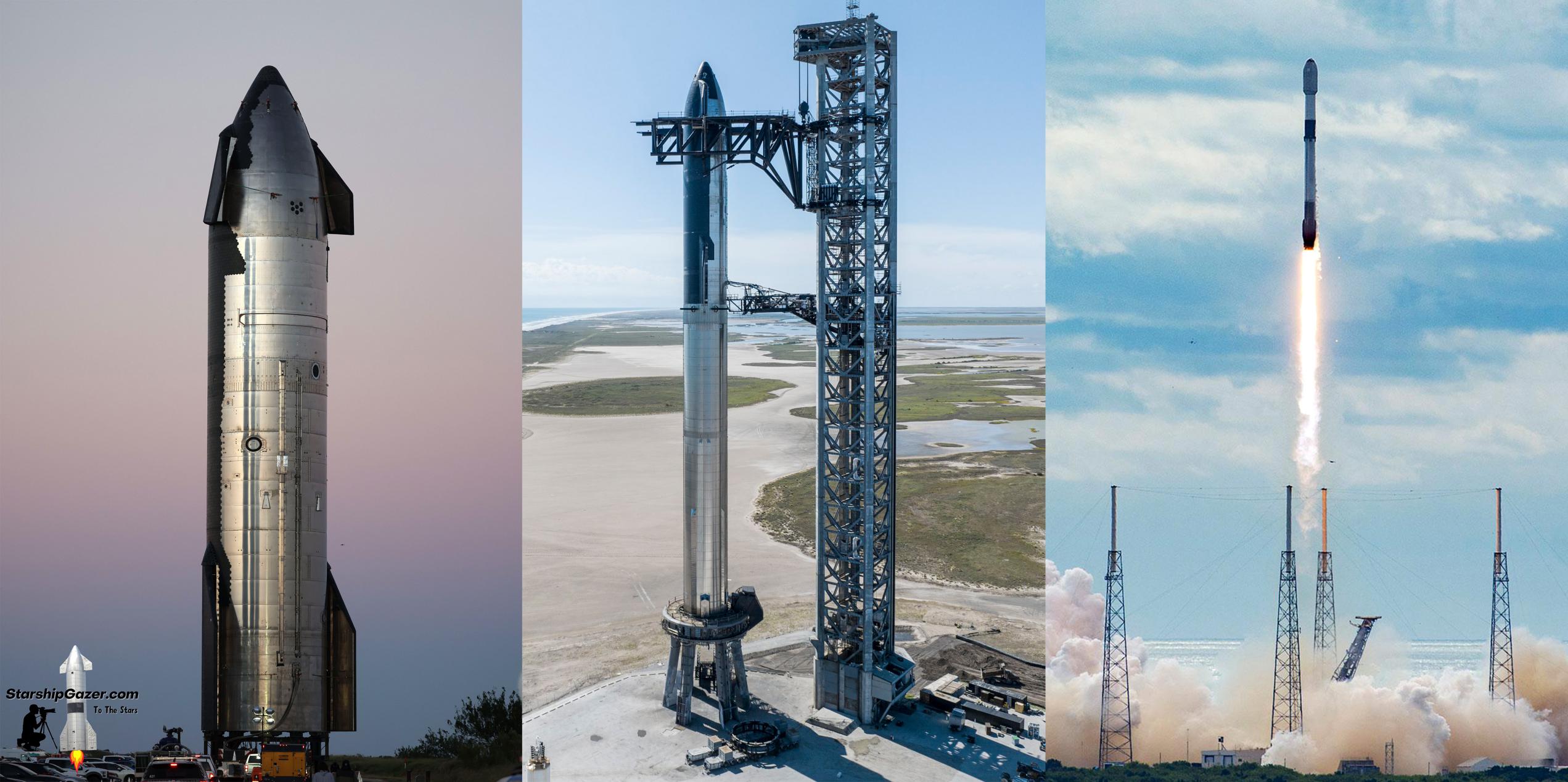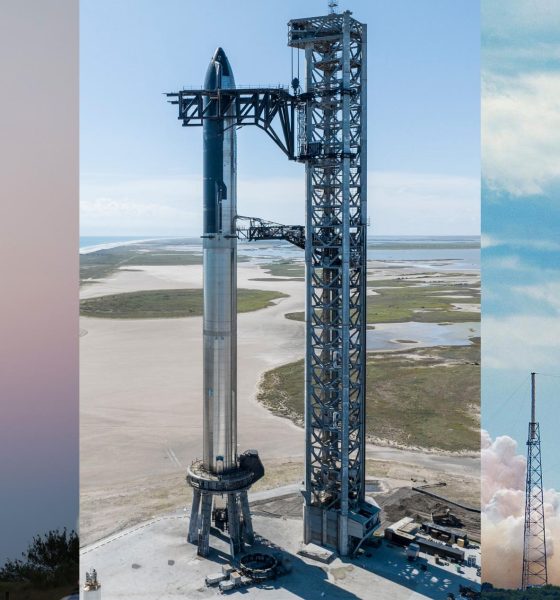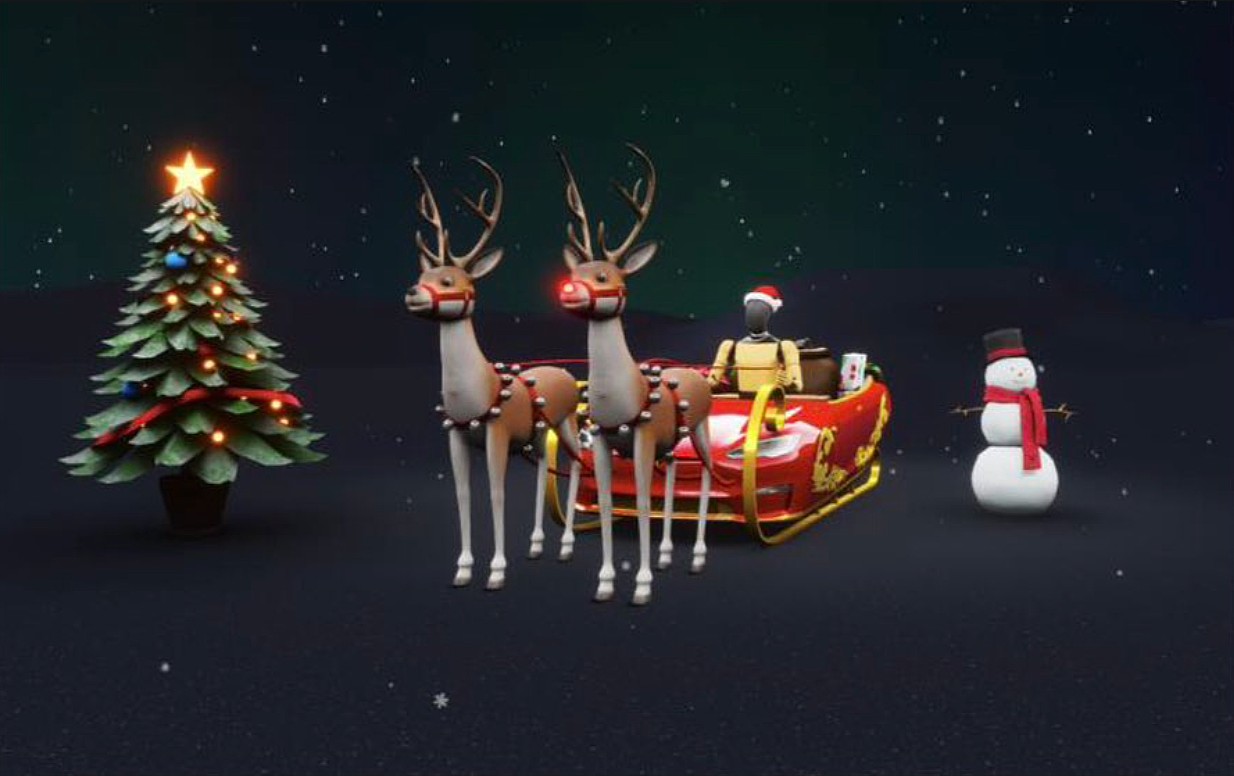

News
SpaceX rolls out Starship, stacks world’s largest rocket, and aces Starlink launch hours apart
In 15 hours, SpaceX has rolled a new Starship to its South Texas launch and test facilities, reassembled the world’s largest rocket, launched Starlink satellites to orbit, and recovered a reused Falcon 9 booster in port.
The burst of activity began around sunset at SpaceX’s Starbase rocket factory in Boca Chica, Texas when a new orbital-class Starship prototype left its ‘nest’ for the first time. SpaceX rolled the Starship – known as Ship 25 – a few miles down the highway to its nearby launch and test facilities, where workers connected it to a large crane and waited for daylight.
Around 9 am CDT the following day, October 20th, SpaceX lifted Ship 25 onto one of two Starship test stands, where it will eventually attempt to complete several qualification tests. While Ship 25 was still suspended in mid-air, the Starbase launch pad’s orbital launch tower began lifting a different prototype, Ship 24, into the air with a pair of giant ‘chopsticks’ – mechanical arms designed by SpaceX to replace one of the largest mobile cranes in the world.
Then, while it was stacking Ship 24 on top of Super Heavy Booster 7 and installing Ship 25 on a test stand, a Falcon 9 rocket carrying 54 new Starlink satellites lifted off from Cape Canaveral, Florida. Minutes prior, SpaceX finished craning a reused Falcon 9 booster off one of its drone ship landing platforms in a port ten miles south.
Starlink 4-36 was SpaceX’s 48th launch of 2022 and 56th launch in less than 12 months, so its Falcon launch program simply doesn’t have time to waste. Drone ship Just Read The Instructions (JRTI) returned to port with Falcon 9 booster B1069 about 12 hours before the rocket was transferred from the ship’s deck to a stand on SpaceX’s Port Canaveral dock space. The company will now be able to retract B1069’s legs and complete any necessary booster and drone ship refurbishment, ensuring that both will be ready for their next missions in the near future.
Back in Texas, SpaceX is scheduled to begin thoroughly testing a fully-stacked Starship rocket for the first time as early as Monday, October 24th. Ship 24 was reinstalled on Booster 7 for that purpose after SpaceX disassembled the pair for several days, possibly due to forecasts of high winds. The test campaign is expected to begin with the first full wet dress rehearsal (WDR) of a two-stage Starship, meaning that the rocket will be fully loaded with thousands of tons of liquid methane and oxygen propellant and run through a simulated launch countdown that ends just before engine ignition.
If successful, SpaceX will likely restart Booster 7 static fire testing and continue to work its way up to the first simultaneous ignition of all 33 of its Raptor 2 engines. If the pair survive WDR and static fire testing, SpaceX could begin preparing the same rocket for Starship’s orbital launch debut.
If significant issues arise during testing, SpaceX could choose to retire Ship 24 and/or Booster 7 and move on to a new and improved pair: likely Ship 25 and Booster 8 or 9. Already complete, Super Heavy Booster 8 has been sitting untouched at Starbase’s launch site for weeks, making it uncertain whether SpaceX actually intends to test or use the prototype. Booster 9 is just one stack away from completion, at which point it will be ready to begin proof testing. According to CEO Elon Musk, B9 features significant improvements that will make it more resilient to mid-flight Raptor engine failures. It could also be the first Super Heavy booster with no hydraulic system, thanks to a new version of Raptor that replaces hydraulic thrust vectoring with a battery-powered alternative.
Starship S25 could kick off its own proof testing as early as next week. Unlike Ship 24, Ship 25 went straight from the factory to a test stand that has been modified with six hydraulic rams. Those rams will simulate the thrust of six Raptor 2 engines (up to ~1400 tons or 3.1M lbf) while the Starship is simultaneously loaded with cryogenic liquid oxygen and/or nitrogen, combining peak mechanical and thermal stresses into one test. Once Ship 25 is done, it will be rolled back to the factory for Raptor engine installation and will eventually return to the pad for static fire testing.

News
Tesla hints at Starlink integration with recent patent
“By employing polymer blends, some examples enable RF transmission from all the modules to satellites and other communication devices both inside and outside the vehicle.”

Tesla hinted at a potential Starlink internet terminal integration within its vehicles in a recent patent, which describes a vehicle roof assembly with integrated radio frequency (RF) transparency.
The patent, which is Pub. No U.S. 2025/0368267 describes a new vehicle roof that is made of RF-transparent polymer materials, allowing and “facilitating clear communication with external devices and satellites.”
Tesla believes that a new vehicle roof design, comprised of different materials than the standard metallic or glass elements used in cars today, would allow the company to integrate modern vehicular technologies, “particularly those requiring radio frequency transmission and reception.
Tesla has recently filed a US patent application on integrating RF transparent materials into the roof structure.
“facilitating clear communication with external devices and satellites”
Tesla fleet is getting @Starlink connectivity integration soon. LFG @Tesla @elonmusk… pic.twitter.com/bLa8YtPLd1
— Chansoo Byeon (@Chansoo) December 9, 2025
Instead of glass or metallic materials, Tesla says vehicles may benefit from high-strength polymer blends, such as Polycarbonate, Acrylonitrile Butadiene Styrene, or Acrylonitrile Styrene Acrylate.
These materials still provide ideal strength metrics for crashworthiness, stiffness for noise, vibration, and harshness control, and are compliant with head impact regulations.
They would also enable better performance with modern technologies, like internet terminals, which need an uninterrupted signal to satellites for maximum reception. Tesla writes in the patent:
“By employing polymer blends, some examples enable RF transmission from all the modules to satellites and other communication devices both inside and outside the vehicle.”

One of the challenges Tesla seems to be aware of with this type of roof design is the fact that it will still have to enable safety and keep that at the forefront of the design. As you can see in the illustration above, Tesla plans to use four layers to increase safety and rigidity, while also combating noise and vibration.
It notes in the patent that disclosed examples still meet the safety requirements outlined in the Federal Motor Vehicle Safety Standards (FMVSS).
Starlink integrated directly into Tesla vehicles would be a considerable advantage for owners. It would come with a handful of distinct advantages.
Initially, the inclusion of Starlink would completely eliminate cellular dead zones, something that is an issue, especially in rural areas. Starlink would provide connectivity in these remote regions and would ensure uninterrupted service during road trips and off-grid adventures.
It could also be a critical addition for Robotaxi, as it is crucial to have solid and reliable connectivity for remote monitoring and fleet management.
Starlink’s growing constellation, thanks to SpaceX’s routine and frequent launch schedule, will provide secure, stable, and reliable internet connectivity for Tesla vehicles.
Although many owners have already mounted Starlink Mini dishes under their glass roofs for a similar experience, it may be integrated directly into Teslas in the coming years, either as an upgrade or a standard feature.
News
Tesla supplements Holiday Update by sneaking in new Full Self-Driving version
It seems Tesla was waiting for the Hardware 4 rollout, as it wanted to also deploy a new Full Self-Driving version to those owners, as it appeared in the release notes for the Holiday Update last night.

Tesla has surprised some owners by sneaking in a new Full Self-Driving version with the wide release of the Holiday Update, which started rolling out to Hardware 4 owners on Friday night.
Tesla has issued a controlled and very slow release pattern with the Holiday Update, which rolls out with Software Version 2025.44.25.5.
For the past two weeks, as it has rolled out to Hardware 3 and older Tesla owners, the company has kept its deployment of the new Software Version relatively controlled.
It seems Tesla was waiting for the Hardware 4 rollout, as it wanted to also deploy a new Full Self-Driving version to those owners, as it appeared in the release notes for the Holiday Update last night.
Tesla Full Self-Driving v14.2.1.25 made its first appearance last night to Hardware 4 owners who are members of the Early Access Program (EAP). It appears to be a slight refinement from FSD v14.2.1, which has been out for a couple of weeks.
Tesla v2025.44.25.5 Holiday update incoming
Also Full Self-Driving v14.2.1.25!!! pic.twitter.com/74D7S0UGXz
— TESLARATI (@Teslarati) December 13, 2025
Many owners welcome the new FSD version, us included, because we’ve been less than impressed with v14.2.1. We have experienced some minor regressions with v14.2.1, especially with Speed Limit recognition, Speed Profile tinkering, and parking performance.
As it stands, Full Self-Driving is still particularly impressive, but Tesla is evidently having an issue with some of the adjustments, as it is still refining some of the performance aspects of the suite. This is expected and normal with some updates, as not all of them are an improvement in all areas; we routinely see some things backtrack every once in a while.
This new FSD version is likely to take care of those things, but it also includes all of the awesome Holiday Update features, which include:
- Grok with Navigation Commands (Beta) – Grok will now add and edit destinations.
- Tesla Photobooth – Take pictures inside your car using the cabin-facing camera
- Dog Mode Live Activity – Check on your four-legged friend on your phone through periodic snapshots taken of the cabin
- Dashcam Viewer Update – Includes new metrics, like steering wheel angle, speed, and more
- Santa Mode – New graphics, trees, and a lock chime
- Light Show Update – Addition of Jingle Rush light show
- Custom Wraps and License Plates – Colorizer now allows you to customize your vehicle even further, with custom patterns, license plates, and tint
- Navigation Improvements – Easier layout and setup
- Supercharger Site Map – Starting at 18 pilot locations, a 3D view of the Supercharger you’re visiting will be available
- Automatic Carpool Lane Routing – Navigation will utilize carpool lanes if enabled
- Phone Left Behind Chime – Your car will now tell you if you left a phone inside
- Charge Limit Per Location – Set a charge limit for each location
- ISS Docking Simulator – New game
- Additional Improvements – Turn off wireless charging pad, Spotify improvements, Rainbow Rave Cave, Lock Sound TRON addition
Tesla also added two other things that were undocumented, like Charging Passport and information on USB drive storage to help with Dashcam.
Cybertruck
Tesla updates Cybertruck owners about key Powershare feature

Tesla is updating Cybertruck owners on its timeline of a massive feature that has yet to ship: Powershare with Powerwall.
Powershare is a bidirectional charging feature exclusive to Cybertruck, which allows the vehicle’s battery to act as a portable power source for homes, appliances, tools, other EVs, and more. It was announced in late 2023 as part of Tesla’s push into vehicle-to-everything energy sharing, and acting as a giant portable charger is the main advantage, as it can provide backup power during outages.
Cybertruck’s Powershare system supports both vehicle-to-load (V2L) and vehicle-to-home (V2H), making it flexible and well-rounded for a variety of applications.
However, even though the feature was promised with Cybertruck, it has yet to be shipped to vehicles. Tesla communicated with owners through email recently regarding Powershare with Powerwall, which essentially has the pickup act as an extended battery.
Powerwall discharge would be prioritized before tapping into the truck’s larger pack.
However, Tesla is still working on getting the feature out to owners, an email said:
“We’re writing to let you know that the Powershare with Powerwall feature is still in development and is now scheduled for release in mid-2026.
This new release date gives us additional time to design and test this feature, ensuring its ability to communicate and optimize energy sharing between your vehicle and many configurations and generations of Powerwall. We are also using this time to develop additional Powershare features that will help us continue to accelerate the world’s transition to sustainable energy.”
Owners have expressed some real disappointment in Tesla’s continuous delays in releasing the feature, as it was expected to be released by late 2024, but now has been pushed back several times to mid-2026, according to the email.
Foundation Series Cybertruck buyers paid extra, expecting the feature to be rolled out with their vehicle upon pickup.
Cybertruck’s Lead Engineer, Wes Morrill, even commented on the holdup:
As a Cybertruck owner who also has Powerwall, I empathize with the disappointed comments.
To their credit, the team has delivered powershare functionality to Cybertruck customers who otherwise have no backup with development of the powershare gateway. As well as those with solar…
— Wes (@wmorrill3) December 12, 2025
He said that “it turned out to be much harder than anticipated to make powershare work seamlessly with existing Powerwalls through existing wall connectors. Two grid-forming devices need to negotiate who will form and who will follow, depending on the state of charge of each, and they need to do this without a network and through multiple generations of hardware, and test and validate this process through rigorous certifications to ensure grid safety.”
It’s nice to see the transparency, but it is justified for some Cybertruck owners to feel like they’ve been bait-and-switched.








